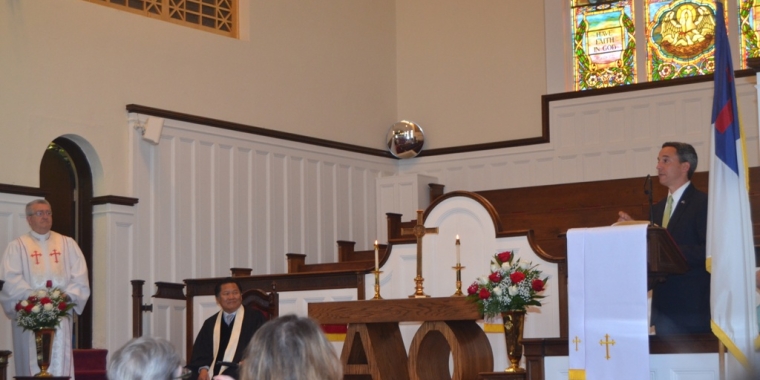From the Desk of Senator Jack M. Martins
Jack M. Martins
February 29, 2012
-
COMMITTEE:
- Local Government
Shade for Our Children
I spent Presidents' Week break away with my wife and our girls and I guess I relaxed as much as a dad with four daughters who text and e-mail actually can. I can’t say that I totally managed to put my Senate work aside either, but my wife says that I was definitely less compulsive about it than usual, so I’ll take that as progress. Anyway, while on break I discovered an interesting book entitled "100 Quotes to Make You Think!" and this particular one struck me as a great metaphor for our government and what we should strive for:
A society grows great when old men plant trees whose shade they know they shall never sit in.
It's a Greek proverb and it's as true today as the day it was first uttered.
Regrettably, politicians too often focus on the immediate and lose sight of long-term needs. With everything that needs fixing right now, little thought is given to what can be done today to solve tomorrow’s problems. If it's not going to get a "thank you" today, the thinking goes, then why do it? Why spend political capital trying to fix something for which we will not see the benefit for decades especially when the enemies we create in doing so will hold us accountable now?
There are numerous examples of this mindset, but it seems especially applicable to recent discussions surrounding public employee pension reform, specifically Governor Cuomo's proposed Tier VI. There are a number of elements to his plan that concern me and that frankly, I take issue with. But most of the resistance we’re hearing about is to two things: the introduction of a 401k-type defined-contribution plan and requiring greater employee contributions to the traditional defined-benefit plan.
The Governor claims that it will save taxpayers tens of billions of dollars over the next 30 years. We have yet to see confirmation of those numbers, but, at its core, it clearly will provide long-term savings to taxpayers and leadership in an area that’s been a political minefield. The question is not, and should not be, whether future public employees deserve a good pension system. We all agree that they do. The issue is whether taxpayers can afford to continue to support the system as is.
Critics of the plan claim it’s an attack on the middle-class, that the option of a 401k-type defined contribution plan is unstable, and that it's not worth implementing, as there are no short-term savings to taxpayers. I disagree.
As for the first concern, to claim the plan is an attack on the middle-class is to have us believe that public employees are the bulk of our middle-class. The truth is the vast majority of the middle-class in New York and throughout the country are private employees who shifted to 401k-type defined contribution plans decades ago. Furthermore, the Governor’s plan simply provides it as an option, not a requirement, allowing newly hired public employees to choose between a 401k-style plan and the traditional defined-benefit plan. Those who choose the defined contribution option would therefore be right in line with the pensions of most private-sector employees. Those who choose the traditional defined benefit would continue with substantially the same system as exists now except with a higher employee contribution rate and a longer term for vesting. Either option provides relief to taxpayers. Far from being an attack on the middle-class, the proposal puts public employees on par with private sector employees in many respects.
In regards to the 401k option being unstable, the fact is the current traditional plan invests in the very same stock market and is prone to exactly the same market fluctuations. The only difference is that under the current plan, any dip in the market must be sustained by taxpayers. That’s why we’re having this conversation. Public pensions are guaranteed by our state constitution, so when stocks sank a few years back, state and local governments were forced to pass those extraordinary costs on to taxpayers. Under the new options, public employees would share more of the burden for their own pensions.
As for the lack of an immediate impact, I refer to the quote that began this column. Are critics implying that we should take no action to avoid the obvious difficulties that we see coming? Should we not try to provide a fairer more sustainable system for future taxpayers - our children and grandchildren - just because there’s a minimal benefit to our own pockets? As a former Mayor, I’m painfully aware that local governments and schools need relief now, especially when dealing with the instability of pension contribution rates. It’s an unfortunate reality that the current system requires taxpayers to pay more precisely when the economy is at its worst. Rest assured that my Senate colleagues and I are simultaneously working on short-term solutions that will address that as well. But long-term and short-terms answers are not and should not be mutually exclusive of each other.
Let’s put things in perspective. Since 2001, pension contributions by state, local governments and schools shot up from $368 million to $6.6 billion. Anyone who says that’s sustainable is lying. While most of this increase is due to fluctuations in pension contribution rates, we must take the opportunity to review the status quo going forward. We’re at a crossroads and well-thought out decisions now can protect public employees while placing taxpayers on solid footing. In light of all the "weeds" we’ve left future generations - debt, entitlements, etc. – maybe it’s about time we plant a few "trees" for them.
Share this Article or Press Release
Newsroom
Go to NewsroomFrom the Desk of Senator Jack M. Martins
June 4, 2015


